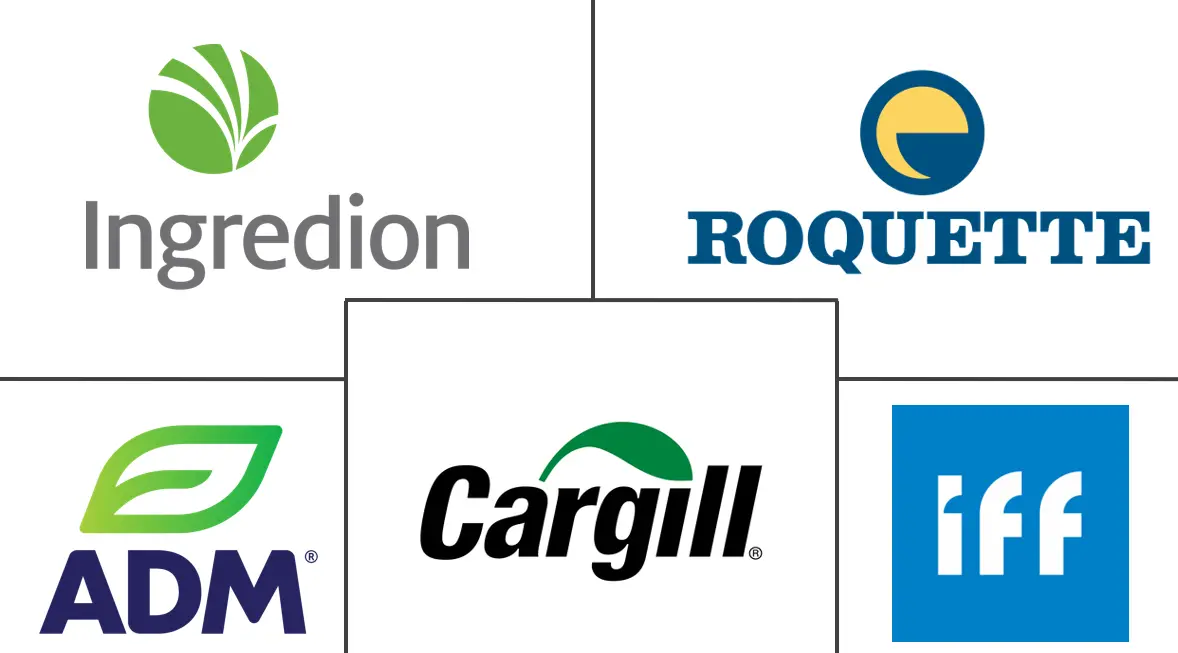Polyol Sweeteners Market Size and Share
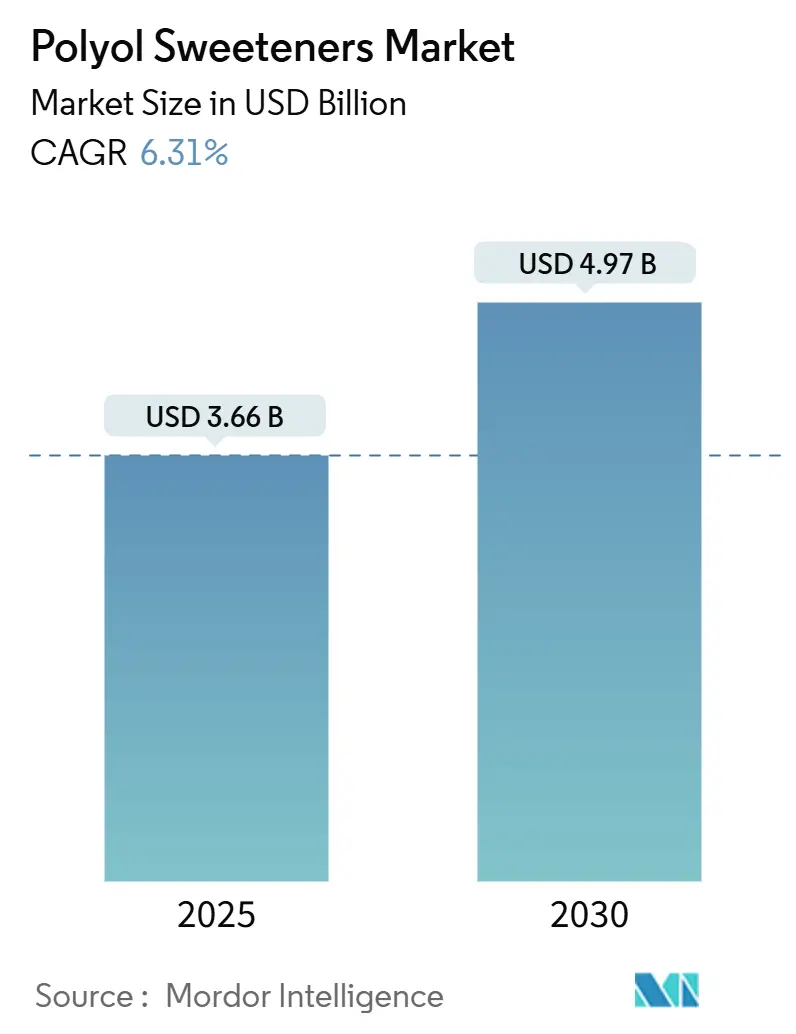
Polyol Sweeteners Market Analysis by Mordor Intelligence
The polyol sweeteners market size is expected to reach USD 3.66 billion in 2025 and is expected to grow to USD 4.97 billion by 2030, at a CAGR of 6.31% during the forecast period. The market growth is driven by increasing consumer demand for healthier alternatives and supportive regulations for low-calorie sweeteners. The rising prevalence of diabetes and obesity worldwide has led consumers to seek sugar substitutes, making polyols an attractive option due to their lower caloric content and minimal impact on blood sugar levels. The European Food Safety Authority's (EFSA) re-evaluation of erythritol (E 968) in December 2023 confirmed its safety as a polyol sweetener. The assessment verified that erythritol is non-genotoxic, maintains blood sugar stability, and retains its properties during food processing. These findings support the continued use of erythritol in food and beverage manufacturing, particularly in diabetic-friendly and low-calorie products[1]Source: European Food Safety Authority, "PLS: Re-evaluation of erythritol (E 968) as a food additive," efsa.europa.eu. Additionally, the food and beverage industry's continuous innovation in sugar-free and reduced-sugar products has increased the adoption of polyols across various applications, including confectionery, baked goods, and dairy products.
Key Report Takeaways
- By product type, sorbitol dominated the polyol sweeteners market with a 33.54% share in 2024, while erythritol is expected to grow at a 6.98% CAGR through 2030.
- By form, powder form held the largest market share at 68.46% in 2024, with liquid formulations projected to achieve a 7.33% CAGR during the forecast period.
- By application, the food and beverages segment accounted for 46.88% of the market in 2024, while the personal care and cosmetics segment is forecast to grow at a 7.03% CAGR.
- By geography, Asia-Pacific emerged as the largest regional market with a 38.83% share in 2024, and South America is expected to register a 7.24% CAGR through 2030.
Global Polyol Sweeteners Market Trends and Insights
Drivers Impact Analysis
| Driver | (~) % Impact on CAGR Forecast | Geographic Relevance | Impact Timeline |
|---|---|---|---|
| Consumer shift towards sugar free confectionery boosting polyols usage | +1.2% | Global, with strong adoption in North America and Europe | Medium term (2-4 years) |
| Rising demand for low-calorie sweeteners in food industry | +1.5% | Global, led by Asia-Pacific and North America | Long term (≥ 4 years) |
| Increasing diabetic population accelerating polyol adoption in food | +1.8% | Global, particularly Asia-Pacific and North America | Long term (≥ 4 years) |
| Surge in clean label trends encouraging use of naturally derived polyols | +0.9% | North America and Europe, expanding to Asia-Pacific | Medium term (2-4 years) |
| Application of sorbitol in pharmaceuticals as laxatives and tablet binders | +0.7% | Global, with strong growth in emerging markets | Long term (≥ 4 years) |
| Expanding pet food market incorporating safe sweetening agent like sorbitol | +0.3% | North America and Europe, emerging in Asia-Pacific | Short term (≤ 2 years) |
| Source: Mordor Intelligence | |||
Consumer shift towards sugar free confectionery boosting polyols usage
The confectionery market is experiencing a significant shift toward sugar-free products due to increasing consumer preferences for reduced sugar consumption. Health-conscious consumers are actively seeking alternatives to traditional sugar-based confectionery products, driving manufacturers to reformulate their offerings. This trend has evolved from serving primarily diabetic consumers to encompassing mainstream confectionery products across various categories, including chocolates, candies, and gummies. Polyols are essential in this transformation as they provide the necessary bulk and texture that intense sweeteners alone cannot deliver. These sugar alcohols maintain the mouthfeel, sweetness profile, and structural integrity of confectionery products while offering reduced caloric content and improved dental benefits compared to conventional sugar-based alternatives. Advancements in polyol blending technologies enable confectionery manufacturers to replicate sugar-like taste profiles while managing costs. The demand for polyols increases as major confectionery companies incorporate these ingredients into their main product lines instead of creating separate sugar-free variants, expanding their use across both premium and mass-market categories.
Rising demand for low-calorie sweeteners in food industry
Food manufacturers increasingly integrate polyols into mainstream product lines as consumer health consciousness reaches unprecedented levels, driven by rising obesity rates and metabolic health awareness. The WHO's 2024 recommendations against using non-sugar sweeteners for weight control specifically exempt polyols from this guidance, recognizing their distinct metabolic profile and functional benefits [2]Source: World Health Organization, “Guideline on the Use of Non-Sugar Sweeteners,” who.int. Advancements in polyol production technology, particularly through microbial fermentation systems using CRISPR technology, are reducing manufacturing costs and increasing production capacity for food manufacturers. These technological improvements enable more efficient production processes and higher yields. The market expansion continues as global regulatory authorities streamline polyol approval procedures, making it easier for companies to introduce new food applications across different regions. This regulatory harmonization has significantly reduced the time and resources required for product approvals, encouraging manufacturers to develop innovative polyol-based food products for various markets.
Increasing diabetic population accelerating polyol adoption in food
The global diabetes epidemic, affecting over 589 million adults worldwide in 2024, according to the International Diabetes Federation, creates sustained demand for polyols as essential ingredients in diabetic-friendly food formulations [3]Source: International Diabetes Federation, "Diabetic Population Worldwide" idf.org. Polyols' minimal impact on blood glucose levels makes them indispensable for diabetes management products. Moreover, the pharmaceutical industry's growing recognition of polyols' therapeutic potential, particularly sorbitol's established role in osmotic therapy and mannitol's use in reducing intracranial pressure, expands market applications beyond food sectors. Asia-Pacific markets show particularly strong growth as diabetes prevalence rises rapidly in emerging economies, while healthcare system reforms improve access to specialized diabetic products. This demographic trend provides long-term market stability, as diabetes management requires sustained dietary modifications that drive consistent polyol consumption patterns.
Surge in clean label trends encouraging use of naturally derived polyols
Consumer demand for recognizable, naturally derived ingredients transforms polyol sourcing strategies, with manufacturers increasingly emphasizing plant-based origins and traditional extraction methods. Xylitol, derived from birch bark and erythritol produced through natural fermentation processes, commands premium pricing as consumers associate natural origins with superior safety profiles. The clean label movement extends beyond ingredient sourcing to production methods, favoring enzymatic and fermentation processes over chemical hydrogenation for polyol manufacturing. Regulatory agencies support this trend through streamlined approval processes for naturally derived polyols, while maintaining stringent safety standards that validate consumer preferences. Food manufacturers leverage clean-label polyols to achieve multiple consumer-preferred claims simultaneously, including "sugar-free," "naturally sweetened," and "clean label," enhancing product positioning across premium market segments. The trend particularly influences personal care and cosmetics applications, where polyols' natural humectant properties align with clean beauty movements emphasizing botanical and naturally derived ingredients.
Restraints Impact Analysis
| Restraint | (~) % Impact CAGR on Forecast | Geographic Relevance | Impact Timeline |
|---|---|---|---|
| High cost of polyols compared to traditional sugar | -1.1% | Global, particularly impacting price-sensitive emerging markets | Medium term (2-4 years) |
| Limited consumer awareness in developing economies | -0.8% | Asia-Pacific emerging markets, South America, Middle East and Africa | Long term (≥ 4 years) |
| Inconsistent labeling regulation | -0.6% | Global, with particular challenges in cross-border trade | Short term (≤ 2 years) |
| Need for technical expertise in polyol formulation for texture optimization | -0.4% | Global, affecting small to medium manufacturers | Medium term (2-4 years) |
| Source: Mordor Intelligence | |||
High cost of polyols compared to traditional sugar
Polyol production costs exceed traditional sugar prices significantly, with erythritol prices 3-4 times higher than sucrose. The complex manufacturing processes, including specialized fermentation and hydrogenation, create high-cost structures that restrict polyol adoption in price-sensitive markets. These processes require substantial investment in equipment, skilled labor, and quality control measures. Sugar price volatility adds to these challenges, as lower sugar prices increase the cost differential and reduce manufacturers' incentives to adopt polyols. This price sensitivity influences product formulation decisions across the food and beverage industry. The production volumes of specialty polyols, such as erythritol and xylitol, remain substantially lower than established polyols like sorbitol, limiting economies of scale. This restricted production capacity results in higher unit costs and reduced operational efficiency. The cost difference particularly affects developing markets, where consumer price sensitivity restricts the adoption of premium ingredients and constrains market growth in regions with high demographic potential. The limited availability of raw materials and processing facilities in these regions further compounds the production cost challenges.
Limited consumer awareness in developing economies
Consumer education gaps in emerging markets restrict the penetration of polyol sweeteners, as limited awareness of health benefits and safety profiles constrains demand growth in demographically favorable regions. Cultural preferences for traditional sweeteners and skepticism toward processed alternatives create adoption barriers that require marketing investment and healthcare provider endorsement. Regulatory infrastructure limitations in developing economies delay polyol approvals and create inconsistent labeling requirements that impede market development. Moreover, educational initiatives require investment in local language materials and healthcare professional training programs, creating market entry costs that discourage smaller companies. The digital divide in emerging markets reduces access to health information that drives polyol adoption in developed economies. Additionally, traditional retail channels lack the expertise to inform consumers about polyol benefits and usage guidelines.
Segment Analysis
By Product Type: Sorbitol Dominance Faces Erythritol Challenge
Sorbitol commands 33.54% of the polyol sweeteners market in 2024, maintaining the largest market share through its extensive applications in food, pharmaceutical, and industrial sectors. In the food industry, sorbitol serves as a bulk sweetener and humectant in sugar-free products, while pharmaceutical applications utilize it as a stabilizer and binding agent in tablet formulations. Its market dominance results from its effectiveness as both a sweetener and functional ingredient, particularly in sugar-free confectionery, diabetic foods, and oral care products.
Erythritol demonstrates the strongest market expansion with a 6.98% CAGR through 2030, driven by its zero-calorie properties and sucrose-like taste profile. Its growing popularity stems from increasing consumer demand for natural, low-calorie sweeteners, especially in beverages, baked goods, and dairy products. The compound's excellent digestive tolerance and tooth-friendly properties further enhance its market appeal. Additionally, maltitol retains a significant market presence in sugar-free confectionery production due to its browning properties and ability to replicate sugar's functionality in chocolate and baked goods.
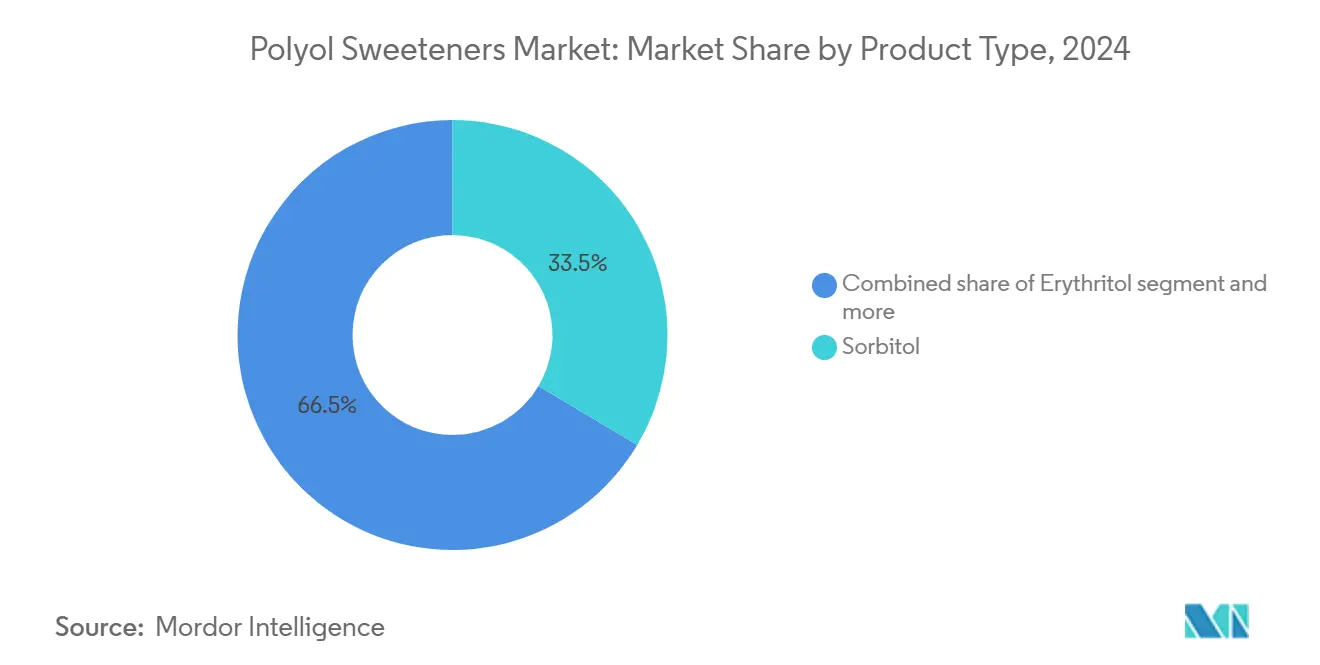
Note: Segment shares of all individual segments available upon report purchase
By Form: Powder Applications Drive Growth
The powder form accounts for 68.46% of the market share in 2024, primarily due to its extensive use in pharmaceutical applications where polyols function as tablet binders, disintegrants, and sweetening agents. This dominance is attributed to the pharmaceutical industry's preference for solid dosage forms and polyols' effective compaction properties that enable direct compression tablet manufacturing. The liquid form segment is projected to grow at 7.33% CAGR through 2030, driven by beverage manufacturers seeking improved dissolution properties and easier integration.
Liquid polyols reduce manufacturing complexity in beverage production by eliminating dissolution steps, particularly in ready-to-drink products. The choice of form varies by polyol type - erythritol is predominantly available in crystalline powder form due to its crystallization characteristics, while sorbitol is utilized in both forms depending on application needs. Manufacturers enhance product differentiation through spray-drying and crystallization control technologies. The pet food industry's increased adoption of liquid polyol formulations for palatability enhancement indicates potential growth in liquid form usage across various market segments.
By Application: Food Dominance Amid Personal Care Expansion
Food and beverages dominate the polyol sweeteners market with a 46.88% share in 2024. This segment encompasses sugar-free confectionery, baked goods, dairy products, and beverages, where polyols serve as bulk and texture enhancers. The segment maintains its leading position through established regulatory approvals, widespread consumer acceptance, and efficient supply chains and manufacturing processes. Personal care and cosmetics applications exhibit the strongest growth trajectory at 7.03% CAGR through 2030, while the pharmaceutical segment maintains steady growth as polyols expand beyond excipients into therapeutic applications.
Industrial applications utilize polyols as chemical intermediates in polyurethane production and as plasticizers, with bio-based variants from renewable sources commanding premium prices in sustainability-focused markets. The other applications include pet food applications, where sorbitol improves palatability in premium products. Market expansion occurs through cross-application development, as food-grade polyols enter personal care formulations and pharmaceutical polyols move into nutraceuticals. Harmonized regulations across applications reduce development costs and accelerate market entry for polyol formulations serving multiple end-use segments.
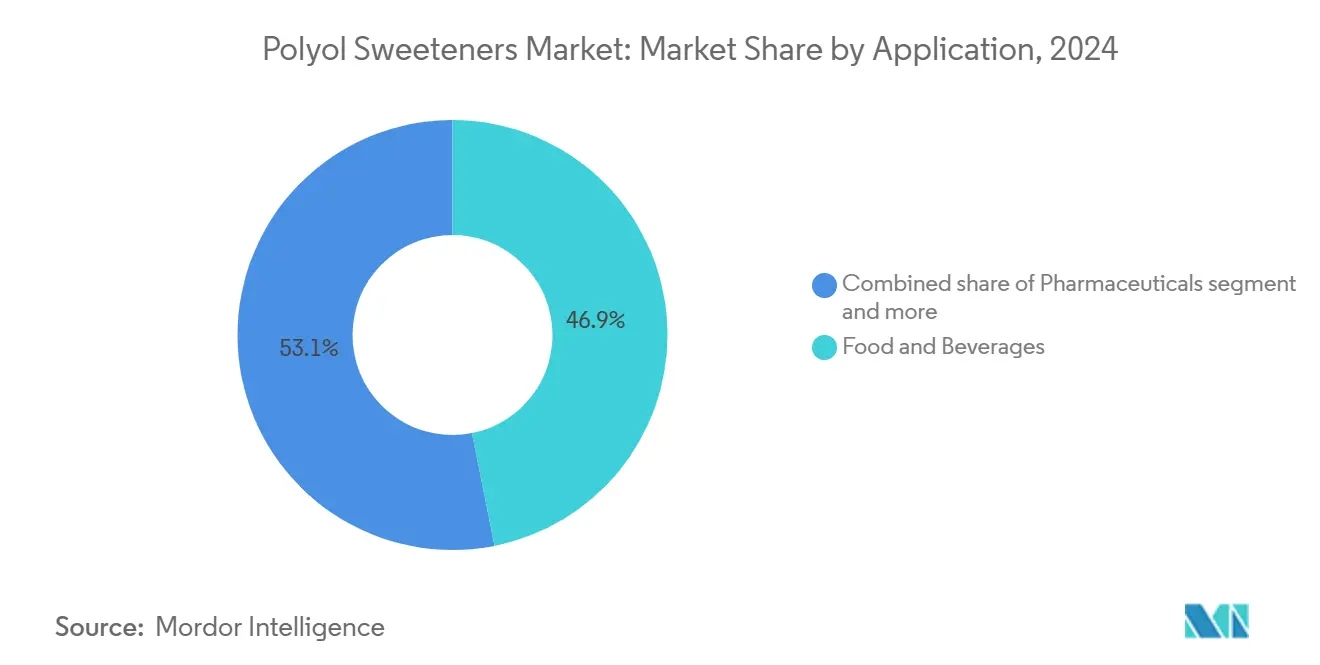
Note: Segment shares of all individual segments available upon report purchase
Geography Analysis
Asia-Pacific holds a 38.83% market share in 2024, positioning itself as a major producer and consumer of polyols. China's manufacturing capacity significantly influences global supply chains. The region's growth stems from expanding pharmaceutical sectors in India and Southeast Asia, where polyols function as excipients in generic drug production. Increased health awareness in urban areas has led to higher consumption of sugar-free products. The region's progress in biotechnology-based polyol production, particularly in fermentation processes, makes it the global center for polyol technology development.
South America exhibits the highest growth rate at 7.24% CAGR through 2030, supported by expanding food processing industries and economic conditions favoring premium ingredient adoption. Government healthcare programs support pharmaceutical sector growth, increasing demand for polyol excipients in generic drugs. The Middle East and Africa offer growth potential, particularly in pharmaceuticals, where improved healthcare infrastructure drives demand for polyol-based drug delivery systems. Economic diversification into food processing and pharmaceutical manufacturing creates opportunities for polyol suppliers with regulatory compliance and local partnerships.
North America and Europe maintain strong market positions through high-value applications and strict regulatory standards that drive polyol formulation innovation. FDA safety assessments and EFSA support for polyols create a stable regulatory environment, encouraging investment in new applications and production methods. These regions lead clean label trends and natural polyol usage, with consumers accepting premium pricing for sustainably sourced and environmentally produced polyols. European regulations promoting sugar reduction in processed foods maintain polyol demand, while North American diabetes management protocols incorporate polyol-containing products in treatment plans.
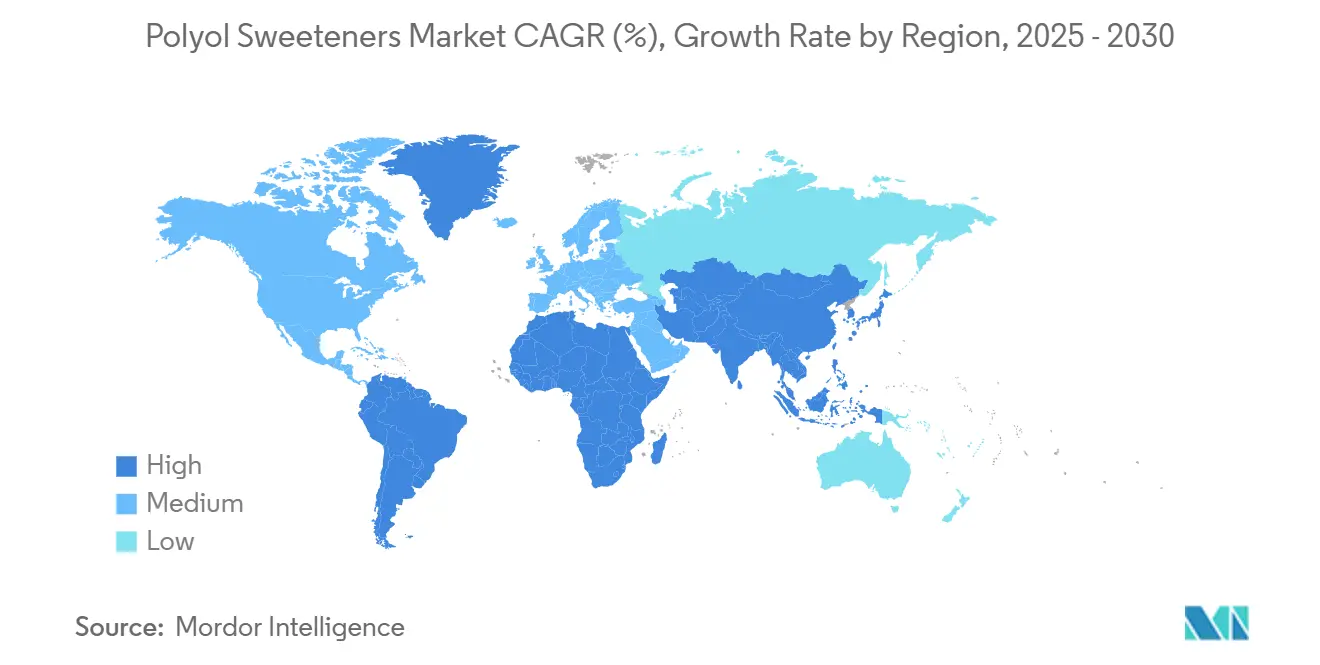
Competitive Landscape
The polyol sweeteners market demonstrates moderate consolidation. The competitive landscape comprises established multinational corporations, biotechnology companies, and regional specialists. Companies like Archer Daniels Midland Company, Cargill Inc., and Ingredion Inc. maintain competitive advantages through extensive distribution networks and integrated supply chains. Roquette Frères and BENEO GmbH differentiate themselves by focusing on specialty applications and premium product segments.
Major players pursue vertical integration strategies, controlling agricultural feedstock sourcing while expanding into food, pharmaceutical, and industrial applications. Companies also implement biotechnology-based production methods, including advanced fermentation processes, to achieve cost advantages in competitive polyol segments.
Untapped opportunities exist in emerging applications, including pet food palatability enhancement and personal care formulations. These areas align with clean label trends but remain underutilized by traditional suppliers. Market disruptors include biotechnology companies developing new production methods and specialty chemical firms creating customized polyol formulations for niche applications.
Polyol Sweeteners Industry Leaders
-
Archer Daniels Midland Company
-
Cargill, Inc
-
Ingredion Incorporated
-
Roquette Frères
-
International Flavors & Fragrances Inc.
- *Disclaimer: Major Players sorted in no particular order
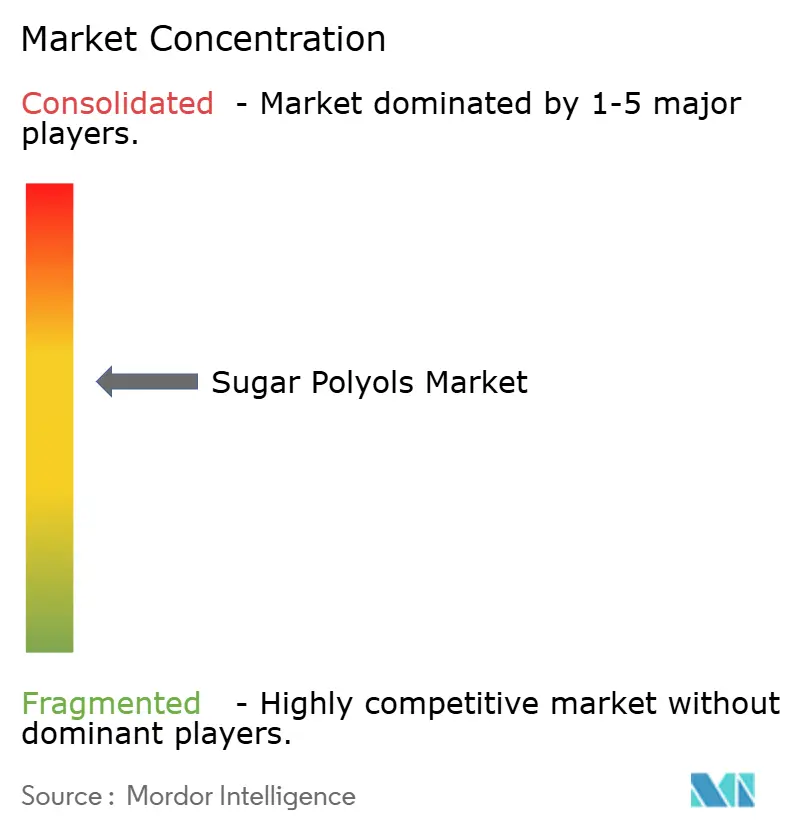


Recent Industry Developments
- January 2025: TEHRAN established the first sorbitol production facility in Iran and West Asia. The plant has an annual production capacity of 7,500 tons of 70% liquid sorbitol, according to Saman Fat'hi, the company's managing director. The facility produces sorbitol for use in the pharmaceutical and food industries.
- July 2024: Covestro (India) opened a new Polyol Tank Farm in Kandla, Gujarat's Kutch district. The facility enhances supply chain efficiency and addresses increasing customer demand. The tank farm stores polyols, essential materials for Covestro's Performance Material Business.
Global Polyol Sweeteners Market Report Scope
Sugar polyols are low-calorie sweeteners used in many food and drinks, such as candy, ice cream, and soda.
The sugar polyols market is segmented by type, application, and geography. Based on type, the market is segmented into erythritol, sorbitol, maltitol, isomalt, and others. The market is segmented into food and beverages, pharmaceuticals, and personal care based on application. Also, the study provides an analysis of the sugar polyols market in emerging and established markets across the world, including North America, Europe, Asia-Pacific, South America, and the Middle East & Africa.
The report offers market sizes and values in (USD Million) during the forecast years for the above segments.
| Erythritol |
| Sorbitol |
| Maltitol |
| Isomalt |
| Others |
| Powder |
| Liquid |
| Food and Beverages |
| Pharmaceuticals |
| Personal Care and Cosmetics |
| Industrial |
| Others |
| North America | United States |
| Canada | |
| Mexico | |
| Rest of North America | |
| Europe | Germany |
| United Kingdom | |
| Italy | |
| France | |
| Spain | |
| Netherlands | |
| Poland | |
| Belgium | |
| Sweden | |
| Rest of Europe | |
| Asia-Pacific | China |
| India | |
| Japan | |
| Australia | |
| Indonesia | |
| South Korea | |
| Thailand | |
| Singapore | |
| Rest of Asia-Pacific | |
| South America | Brazil |
| Argentina | |
| Colombia | |
| Chile | |
| Peru | |
| Rest of South America | |
| Middle East and Africa | South Africa |
| Saudi Arabia | |
| United Arab Emirates | |
| Nigeria | |
| Egypt | |
| Morocco | |
| Turkey | |
| Rest of Middle East and Africa |
| By Product Type | Erythritol | |
| Sorbitol | ||
| Maltitol | ||
| Isomalt | ||
| Others | ||
| By Form | Powder | |
| Liquid | ||
| By Application | Food and Beverages | |
| Pharmaceuticals | ||
| Personal Care and Cosmetics | ||
| Industrial | ||
| Others | ||
| By Geography | North America | United States |
| Canada | ||
| Mexico | ||
| Rest of North America | ||
| Europe | Germany | |
| United Kingdom | ||
| Italy | ||
| France | ||
| Spain | ||
| Netherlands | ||
| Poland | ||
| Belgium | ||
| Sweden | ||
| Rest of Europe | ||
| Asia-Pacific | China | |
| India | ||
| Japan | ||
| Australia | ||
| Indonesia | ||
| South Korea | ||
| Thailand | ||
| Singapore | ||
| Rest of Asia-Pacific | ||
| South America | Brazil | |
| Argentina | ||
| Colombia | ||
| Chile | ||
| Peru | ||
| Rest of South America | ||
| Middle East and Africa | South Africa | |
| Saudi Arabia | ||
| United Arab Emirates | ||
| Nigeria | ||
| Egypt | ||
| Morocco | ||
| Turkey | ||
| Rest of Middle East and Africa | ||


Key Questions Answered in the Report
What is driving the sugar polyol market in 2025?
Growing diabetes prevalence, regulatory pressure to cut sugar, and consumer demand for clean-label, low-calorie products are the primary forces behind the market’s 6.31% CAGR.
Which polyol type is expected to grow fastest through 2030?
Erythritol leads with a 6.98% CAGR because its zero-calorie profile and sugar-like taste meet reformulation needs across snacks, drinks, and personal care items.
How large is the Asia-Pacific share of the sugar polyol market?
Asia-Pacific accounted for 38.83% of global revenue in 2024, supported by significant manufacturing capacity and rising regional demand.
Why are liquid polyol formulations gaining traction?
Beverage and pet-food producers prefer liquids for easier integration and processing efficiency, resulting in a forecast 7.33% CAGR for the segment.
Page last updated on:
